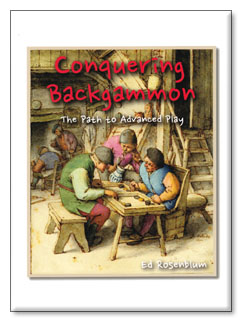
|
Backgammon Books |
 |
|||||||||||
|
Conquering Backgammon The path to advanced play |
|||||||||||
 |
|||||||||||
| AUTHOR: | Ed Rosenblum |
||||||||||
| YEAR: | 2015 |
||||||||||
| PUBLISHER: | Essential Backgammon |
||||||||||
| CITY: | Santa Fe, New Mexico |
||||||||||
| ISBN: | 1936672944 |
||||||||||
| ISBN-13: | 978-1936672943 |
||||||||||
| BINDING: | Hardcover |
||||||||||
| PAGES: | viii+256 |
||||||||||
| SIZE: | 26 cm high, 18 cm wide |
||||||||||
| WEBSITE: |
http://www.essentialbg.com/conquering-backgammon.html |
||||||||||
| DESCRIPTION: |
|
||||||||||
|
READERS COMMENTS: |

 
 |
||||||||||
| CONTENTS: |
|
||||||||||
| QUOTES: |
"Conquering Backgammon is impressive in its content and masterful in its presentation. With the included bot support, I can imagine the volume supplanting a book such as Magriel's 'Backgammon' as the standard introductory backgammon primer. In addition, the second part of the book will elevate intermediate players to an advanced level and beyond."—Bill Riles, President, USBGF "I recommend Conquering Backgammon to all of my students and to anyone interested in improving their game. The book is extremely well-organized, beautifully illustrated, and the information is current and spot on. It is presented in two volumes. The first volume is designed for beginners or as a refresher for people getting back into the game. The second volume contains all the ingredients to move the beginner or intermediate player to an advanced level. It would be impossible to read this book and not see major improvements in one’s game. Highly recommended."—Phil Simborg, Official Teaching Professional, USBGF "Wow, Wow, Wow, Ed really has a gift for explanations. I learned a lot, especially how to use strategies and formulas for positional doubling and racing doubles. Best explanation I have ever read regarding the doubling cube. Love the reference positions, especially with blitz. The Appendix that includes plays at Gammon Go, Gammon Save, and Double Match Point is invaluable. I am confident that Conquering Backgammon will take my game to the next level."—Julius High, First place winner of 2014 Atlanta, Madison, & Kansas City Championships |
||||||||||
|
ABOUT THE AUTHOR: |
I was addicted to it in the seventies and continued to play often in the ensuing years. I joined clubs, started clubs, played in chouettes, read whatever I could find. After moving to Santa Fe, I joined the Backgammon club of Santa Fe. I headed up to my first ABT (American Backgammon Tour) tournament in the Fall of 2009. I decided to play in the Open and thanks to some backgammon street smarts and very kind dice gods, I went on to finish second against an outstanding field of backgammon giants. More than that, I was re-hooked into this exciting game but realized how much it had changed in the past twenty years. Players could now analyze games and positions with powerful computerized backgammon programs that didn't exist in the seventies. "Correct plays" from the seventies had to be re-examined. Thus began my journey. Much of this book is an outgrowth of that discovery process. Teaching backgammon for many years has helped me understand what students can learn easily and what is more difficult. Using eXtreme Gammon, I analyzed thousands of positions and categorized them into critical playing concepts. These concepts were continuously refined based on student feedback and then factored into underlying principles. |
||||||||||
 |
|||||||||||
 
|
|
 
|
||||||
|
Copyright © 1996-2016 by Tom Keith
| ||||||||
